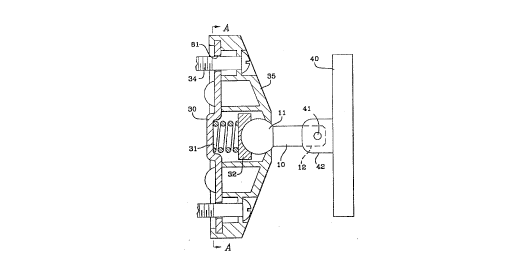Some of the information on this Web page has been provided by external sources. The Government of Canada is not responsible for the accuracy, reliability or currency of the information supplied by external sources. Users wishing to rely upon this information should consult directly with the source of the information. Content provided by external sources is not subject to official languages, privacy and accessibility requirements.
Any discrepancies in the text and image of the Claims and Abstract are due to differing posting times. Text of the Claims and Abstract are posted:
| (12) Patent: | (11) CA 2099386 |
|---|---|
| (54) English Title: | ARMATURE ASSEMBLY FOR ELECTROMAGNETIC DOOR HOLDER |
| (54) French Title: | FERRURES POUR DISPOSITIF ELECTROMAGNETIQUE DE RETENUE DE PORTE |
| Status: | Deemed expired |
| (51) International Patent Classification (IPC): |
|
|---|---|
| (72) Inventors : |
|
| (73) Owners : |
|
| (71) Applicants : | |
| (74) Agent: | NORTON ROSE FULBRIGHT CANADA LLP/S.E.N.C.R.L., S.R.L. |
| (74) Associate agent: | |
| (45) Issued: | 1997-09-23 |
| (86) PCT Filing Date: | 1992-07-27 |
| (87) Open to Public Inspection: | 1993-05-09 |
| Examination requested: | 1993-06-28 |
| Availability of licence: | N/A |
| (25) Language of filing: | English |
| Patent Cooperation Treaty (PCT): | Yes |
|---|---|
| (86) PCT Filing Number: | PCT/US1992/006196 |
| (87) International Publication Number: | WO1993/009320 |
| (85) National Entry: | 1993-06-28 |
| (30) Application Priority Data: | ||||||
|---|---|---|---|---|---|---|
|
An armature assembly for use with an electromagnetic
door holder has a ball stud (10) pivotably connected at one
end of a mounting bracket (30) and at the other end to an
armature plate (40). The mounting bracket (30) is mounted on a
first structural member, a mounting body (35) is secured to the
bracket and connects with the ball stud, and the armature
plate (40) coacts with and is held against an electromagnet
which is mounted on a second structural member. The pivotable
attachments at both ends of the ball stud provide an almost
universal adjustability to the armature assembly and,
thus, accommodate complex misalignments between the first
and second structural surfaces.
rmature pour utilisation avec un système de retenue de porte électromagnétique comprenant une queue de rotule hémisphérique (10) connectée de manière à pivoter à l'une des extrémités d'un support de fixation (30) et à l'autre extrémité, à une plaque d'armature (40). Le support de fixation (30) est assemblé sur un premier élément structural, un corps d'assemblage (35) est fixé à la fixation et est relié à la queue de rotule hémisphérique, et la plaque d'armature (40) agit de concert avec un électro-aimant fixé à un deuxième élément structural et est retenue contre l'électro-aimant. Les accessoires pivotants aux deux extrémités de la queue de rotule hémisphérique procurent un ajustement presque universel à l'armature et, par conséquent, s'adaptent aux désalignements complexes entre les première et deuxième surfaces structurales.
Note: Claims are shown in the official language in which they were submitted.
Note: Descriptions are shown in the official language in which they were submitted.

For a clearer understanding of the status of the application/patent presented on this page, the site Disclaimer , as well as the definitions for Patent , Administrative Status , Maintenance Fee and Payment History should be consulted.
| Title | Date |
|---|---|
| Forecasted Issue Date | 1997-09-23 |
| (86) PCT Filing Date | 1992-07-27 |
| (87) PCT Publication Date | 1993-05-09 |
| (85) National Entry | 1993-06-28 |
| Examination Requested | 1993-06-28 |
| (45) Issued | 1997-09-23 |
| Deemed Expired | 2004-07-27 |
There is no abandonment history.
| Fee Type | Anniversary Year | Due Date | Amount Paid | Paid Date |
|---|---|---|---|---|
| Application Fee | $0.00 | 1993-06-28 | ||
| Registration of a document - section 124 | $0.00 | 1994-05-13 | ||
| Registration of a document - section 124 | $0.00 | 1994-05-13 | ||
| Maintenance Fee - Application - New Act | 2 | 1994-07-27 | $100.00 | 1994-07-04 |
| Maintenance Fee - Application - New Act | 3 | 1995-07-27 | $100.00 | 1995-06-29 |
| Maintenance Fee - Application - New Act | 4 | 1996-07-29 | $100.00 | 1996-06-28 |
| Final Fee | $300.00 | 1997-04-14 | ||
| Maintenance Fee - Application - New Act | 5 | 1997-07-28 | $150.00 | 1997-07-10 |
| Maintenance Fee - Patent - New Act | 6 | 1998-07-27 | $150.00 | 1998-07-08 |
| Maintenance Fee - Patent - New Act | 7 | 1999-07-27 | $150.00 | 1999-07-02 |
| Maintenance Fee - Patent - New Act | 8 | 2000-07-27 | $150.00 | 2000-07-04 |
| Maintenance Fee - Patent - New Act | 9 | 2001-07-27 | $150.00 | 2001-07-03 |
| Maintenance Fee - Patent - New Act | 10 | 2002-07-29 | $200.00 | 2002-07-03 |
Note: Records showing the ownership history in alphabetical order.
| Current Owners on Record |
|---|
| VON DUPRIN, INC. |
| Past Owners on Record |
|---|
| NEW, MARK A. |
| ZIMMERMAN, MICHAEL |